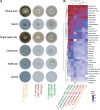Enemy or ally: a genomic approach to elucidate the lifestyle of Phyllosticta citrichinaensis
- PMID: 35311955
- PMCID: PMC9073689
- DOI: 10.1093/g3journal/jkac061
Enemy or ally: a genomic approach to elucidate the lifestyle of Phyllosticta citrichinaensis
Abstract
Members of the fungal genus Phyllosticta can colonize a variety of plant hosts, including several Citrus species such as Citrus sinensis (orange), Citrus limon (lemon), and Citrus maxima (pomelo). Some Phyllosticta species have the capacity to cause disease, such as Citrus Black Spot, while others have only been observed as endophytes. Thus far, genomic differences underlying lifestyle adaptations of Phyllosticta species have not yet been studied. Furthermore, the lifestyle of Phyllosticta citrichinaensis is ambiguous, as it has been described as a weak pathogen but Koch's postulates may not have been established and the presence of this species was never reported to cause any crop or economic losses. Here, we examined the genomic differences between pathogenic and endophytic Phyllosticta spp. colonizing Citrus and specifically aimed to elucidate the lifestyle of Phyllosticta citrichinaensis. We found several genomic differences between species of different lifestyles, including groups of genes that were only present in pathogens or endophytes. We also observed that species, based on their carbohydrate active enzymes, group independent of their phylogenetic association, and this clustering correlated with trophy prediction. Phyllosticta citrichinaensis shows an intermediate lifestyle, sharing genomic and phenotypic attributes of both pathogens and endophytes. We thus present the first genomic comparison of multiple citrus-colonizing pathogens and endophytes of the genus Phyllosticta, and therefore provide the basis for further comparative studies into the lifestyle adaptations within this genus.
Keywords: CAZymes; citrus; endophyte; fungal plant pathogens; genomics; lifestyle adaptations; pathogen.
© The Author(s) 2022. Published by Oxford University Press on behalf of Genetics Society of America.
Conflict of interest statement
None declared.
Figures





Similar articles
-
Mating-type locus rearrangements and shifts in thallism states in Citrus-associated Phyllosticta species.Fungal Genet Biol. 2020 Nov;144:103444. doi: 10.1016/j.fgb.2020.103444. Epub 2020 Aug 18. Fungal Genet Biol. 2020. PMID: 32822858
-
Comparative genome analysis of Phyllosticta citricarpa and Phyllosticta capitalensis, two fungi species that share the same host.BMC Genomics. 2019 Jul 5;20(1):554. doi: 10.1186/s12864-019-5911-y. BMC Genomics. 2019. PMID: 31277573 Free PMC article.
-
Phyllosticta citricarpa and sister species of global importance to Citrus.Mol Plant Pathol. 2019 Dec;20(12):1619-1635. doi: 10.1111/mpp.12861. Epub 2019 Sep 11. Mol Plant Pathol. 2019. PMID: 31512371 Free PMC article. Review.
-
Carbon utilization and growth-inhibition of citrus-colonizing Phyllosticta species.Fungal Biol. 2021 Oct;125(10):815-825. doi: 10.1016/j.funbio.2021.05.003. Epub 2021 May 28. Fungal Biol. 2021. PMID: 34537177
-
Dissecting endophytic lifestyle along the parasitism/mutualism continuum in Arabidopsis.Curr Opin Microbiol. 2016 Aug;32:103-112. doi: 10.1016/j.mib.2016.05.008. Epub 2016 Jun 6. Curr Opin Microbiol. 2016. PMID: 27280851 Review.
Cited by
-
Nematicidal and Insecticidal Compounds from the Laurel Forest Endophytic Fungus Phyllosticta sp.Molecules. 2024 Sep 26;29(19):4568. doi: 10.3390/molecules29194568. Molecules. 2024. PMID: 39407499 Free PMC article.
References
-
- Arafat K. A novel isolate of Phyllosticta capitalensis causes black spot disease on guava fruit in Egypt. Asian J Plant Pathol. 2018;12(1):27–37.
-
- Buijs VA, Zuijdgeest XCL, Groenewald JZ, Crous PW, de Vries RP. Carbon utilization and growth-inhibition of citrus-colonizing Phyllosticta species. Fungal Biol. 2021;125(10):815–825. - PubMed
-
- Chiapello H, Mallet L, Guérin C, Aguileta G, Amselem J, Kroj T, Ortega-Abboud E, Lebrun M-H, Henrissat B, Gendrault A, et al. Deciphering genome content and evolutionary relationships of isolates from the fungus Magnaporthe oryzae attacking different host plants. Genome Biol Evol. 2015;7(10):2896–2912. - PMC - PubMed
Publication types
MeSH terms
Supplementary concepts
LinkOut - more resources
Full Text Sources
Miscellaneous
